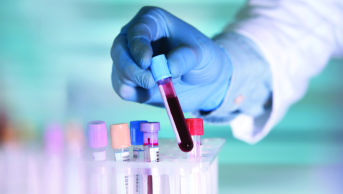
Shutterstock.com
Accurate diagnosis of a lower urinary tract infection (UTI) in women aged under 65 years should be based on a positive dipstick test result for nitrite, alongside two or more urinary symptoms, new guidelines from the Scottish Intercollegiate Guidelines Network (SIGN) say.
SIGN — which produces clinical guidelines for the NHS in Scotland — is also now recommending the use of non-steroidal anti-inflammatory drugs (NSAIDs) as a first-line treatment for women aged under 65 years with uncomplicated lower UTI, who describe their symptoms as mild, and as an alternative to antibiotics when symptoms are moderate to severe.
The guidelines differ from recommendations made by Public Health England, which advise using urine dipsticks ”to increase diagnostic certainty” and reduce unnecessary antibiotics in women aged under 65 years with no symptoms or with one key symptom — either dysuria, new nocturia or cloudy urine.
The latest SIGN guidelines, published on 28 September 2020, replace SIGN 88: Management of suspected bacterial urinary tract infection in adults, which was first published in July 2006 and updated in July 2012, and had previously advised using dipstick tests to guide treatment decisions in otherwise healthy women aged under 65 years with either mild or no more than two UTI symptoms.
However, the new guidelines note that “all studies” considered by the guideline development group showed the benefit of dipstick testing to “rule in or rule out a UTI”.
The guidelines say that for lower UTI, in women aged under 65 years, to “diagnose a UTI in the presence of two or more urinary symptoms (dysuria, frequency, urgency, visible haematuria or nocturia) and a positive dipstick test result for nitrite”.
It adds that, before carrying out a dipstick test, urine should be retained in the bladder for at least four hours to allow conversion of urinary nitrates to nitrite by pathogens, warning that shorter retention times “may lead to false negative results”.
Jacqueline Sneddon, chair of the group that developed the latest SIGN guidelines, told The Pharmaceutical Journal: “When we looked at the evidence for the various contributions of each symptom to how accurate the diagnosis was, we found that adding dipstick testing increased the accuracy.”
“It is possible to still empirically treat people on signs and symptoms, but combining symptoms with dipstick [testing] is the best option — and it may prevent unnecessary use of antibiotics,” she added.
Sneddon, who is also chair of the Royal Pharmaceutical Society Antimicrobial Expert Advisory Group, acknowledged that, in the short term, it would be a challenge to implement the recommendations in some care settings, such as community pharmacy.
“In community pharmacy practice, it is relatively uncommon for UTI assessment to include use of urinalysis, although it has previously been a part of some local services … going forward we would anticipate that pharmacists could be given the opportunity to receive additional training and support to allow urinalysis to become part of standard practice.
“This aligns with the gradual but definite move towards community pharmacists being supported and funded by the NHS to manage a wider range of common medical conditions.”
On 29 July 2020, NHS Pharmacy First
went live across the Scottish community pharmacy network, which reimburses pharmacists for advice and referrals as well as for dispensing medicine under the service.
Commenting on the SIGN recommendation that NSAIDs should be used as first-line treatment in women aged below 65 years, Sneddon said that the approach should be used on an “individual patient basis” through a shared decision-making discussion with the patient.
“It is important to provide safety information for patients that explains that should [their symptoms] get worse, they should reconsult. The evidence shows that in trials where they’ve compared NSAIDs with antibiotics, more people went on to develop upper UTI, so patients should be alert [to this risk].”
For cases where antimicrobials are prescribed, the guidance recommends a short, three-day course, which is “clinically effective” and minimises the risk of adverse events. However, it says that some patients may prefer to avoid taking antibiotics and prefer a ‘watch and wait’ approach if symptoms are not severe.
Many UTI symptoms in younger women will resolve themselves and can be managed with self-care, or analgesia, Sneddon added.
The SIGN guideline does not cover the diagnosis and management of upper UTI; UTI in children aged under 16 years; UTI in pregnant women; UTI in men; or interstitial cystitis and bladder pain syndromes.


